General Staff (Sweden)
The General Staff (Swedish: Generalstaben, Gst) was a Swedish government agency established in 1873 and was active until 1937.
| General Staff | |
|---|---|
| Generalstaben | |
| Active | 1873–1937 |
| Country | Sweden |
| Allegiance | Swedish Armed Forces |
| Branch | Joint |
| Type | Staff |
| Role | Operational, territorial and tactical activities |
| Part of | Ministry of Land Defence |
| Garrison/HQ | Stockholm |
| Insignia | |
| Branch insignia m/1906 | 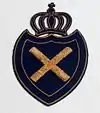 |
| Baldric |  |
History
The General Staff was established in 1873 (SFS 1873:87). Its tasks was to contribute to the military science education in the army, train their officers and deliver them to the service of other agencies, study militarism abroad, elaborate plans for the army's mobilization and its concentration on different battlefields, write the country's military history and nurture its military historical archives, perform the country's military mapping and its study and description in military terms (whereby the Topographical Corps was merged with the General Staff).[1]
The General Staff was initially organized with a chief with a head office and four departments: the Communications Department (1873-1937), Military Statistics Department (1873-1908), Military History Department (1873-1937) with the Military Archives and Topographical Department (1873-1937).[1]
The task to handle the nations military mapping was transferred to the Geographical Survey Office of Sweden (Rikets allmänna kartverk) in 1894. The Military Statistics Department was divided in 1908 into three: the Central Department, Organization Department and the International Department. In 1912 the Communications Department was divided. One part retained the old name, and devoted themselves to the actual transportation policy. The other was called the Technical Department and devoted themselves to the telegraph, telephone, balloons, airplanes, cars and more.[1]
The Technical Department dissolved on 17 December 1931 and was replaced by the Education Department, which also dealt with questions about regulations and instructions relating to the education. The General Staff ceased to exist on 1 July 1937 and its duties were taken over firstly by the Defence Staff and the Army Staff.[1]
Chiefs of the General Staff
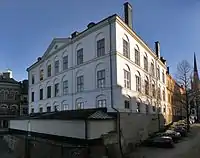

| No. | Portrait | Chief of the General Staff | Took office | Left office | Time in office | Defence branch | Monarch | Ref |
|---|---|---|---|---|---|---|---|---|
| 1 | Colonel Hugo Raab (1831–1881) | 5 December 1873 | 1881 | 7–8 years |  Army | Oscar II | [3] | |
| 2 | Major general Axel Ryding (1831–1897) | 9 February 1882 | 1885 | 2–3 years |  Army | Oscar II | [4] | |
| - | Colonel Axel Rappe (1838–1918) Acting | 14 July 1882 | 1885 | 2–3 years |  Army | Oscar II | [5] | |
| 3 | Major general Axel Rappe (1838–1918) | 30 December 1885 | 1905 | 19–20 years |  Army | Oscar II | [5] | |
| - | Colonel Ernst von der Lancken (1841–1902) Acting | 25 June 1892 | 4 October 1895 | 3 years, 101 days |  Army | Oscar II | [6] | |
| - | Colonel Casten Warberg (1845–1910) Acting | 1895 | 1899 | 3–4 years |  Army | Oscar II | - | |
| - | Colonel Knut Gillis Bildt (1854–1927) Acting | 3 February 1899 | 9 December 1899 | 309 days |  Army | Oscar II | [7] | |
| - | Major general Knut Gillis Bildt (1854–1927) Acting | 25 September 1905 | 3 November 1905 | 39 days |  Army | Oscar II | [7] | |
| 4 | Major general Knut Gillis Bildt (1854–1927) | 3 November 1905 | 1919 | 13–14 years |  Army | Oscar II Gustaf V | [7] | |
| 5 | Lieutenant general Lars Tingsten (1857–1937) | 1919 | 1922 | 2–3 years |  Army | Gustaf V | - | |
| 6 | Major general Carl Gustaf Hammarskjöld (1865–1940) | 14 June 1922 | 1930 | 7–8 years |  Army | Gustaf V | [8] | |
| 7 | Major general Bo Boustedt (1868–1939) | 1930 | 28 August 1933 | 2–3 years |  Army | Gustaf V | [9] | |
| 8 | Lieutenant general Oscar Nygren (1872–1960) | 29 August 1933 | 30 June 1937 | 3 years, 305 days |  Army | Gustaf V | [10] |
References
| Wikimedia Commons has media related to General Staff. |
- "Generalstaben (1873 – 1937)" [The General Staff (1873 – 1937)] (in Swedish). National Archives of Sweden. Retrieved 23 March 2016.
- "Schering Rosenhanes palats på Riddarholmen" [Schering Rosenhane's Palace at Riddarholmen] (in Swedish). National Property Board of Sweden. Retrieved 11 June 2016.
- Ericson, Lars (1995–1997). "C F Hugo Raab". Svenskt biografiskt lexikon (in Swedish). 29. National Archives of Sweden. p. 591. Retrieved 2017-10-27.
- Nevéus, Torgny (2000–2002). "K Axel Ryding". Svenskt biografiskt lexikon (in Swedish). 31. National Archives of Sweden. p. 104. Retrieved 2017-10-27.
- Åselius, Gunnar (1995–1997). "Axel E Rappe". Svenskt biografiskt lexikon (in Swedish). 29. National Archives of Sweden. p. 687. Retrieved 2017-10-27.
- Bertil, Broomé (1977–1979). "Ernst F Lancken, von der". Svenskt biografiskt lexikon (in Swedish). 22. National Archives of Sweden. p. 224. Retrieved 2017-10-27.
- Boëthius, B. (1924). "Knut Gillis Bildt". Svenskt biografiskt lexikon (in Swedish). 4. National Archives of Sweden. p. 336. Retrieved 2017-10-27.
- Hildebrand, Bengt (1969–1971). "Carl Gustaf V Hammarskjöld". Svenskt biografiskt lexikon (in Swedish). 18. National Archives of Sweden. p. 187. Retrieved 2017-10-27.
- Kjellberg, H. E., ed. (1934). Svenska Dagbladets årsbok ELFTE ÅRGÅNGEN (Händelserna 1933) [Svenska Dagbladet's Yearbook ELEVENTH VOLUME (Events of 1933)] (in Swedish). Stockholm: Svenska Dagbladet. p. 40.
- Cronenberg, Arvid (1990–1991). "Oscar E Nygren". Svenskt biografiskt lexikon (in Swedish). 27. National Archives of Sweden. p. 704. Retrieved 2017-10-27.

_KBGF.052666.jpg.webp)

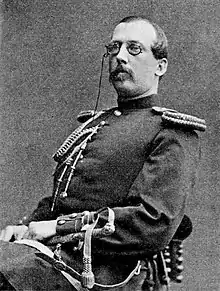
.jpg.webp)
.jpg.webp)
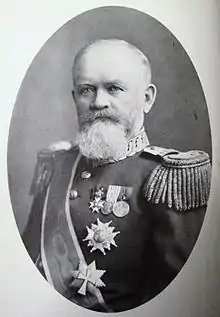
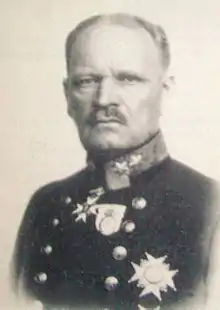
.jpg.webp)
